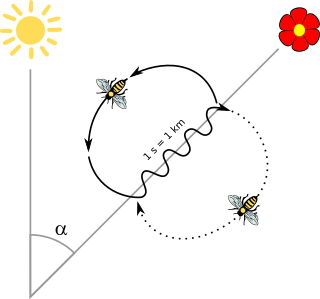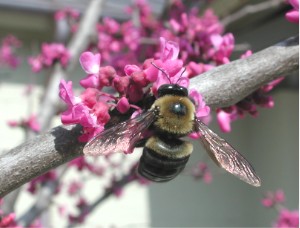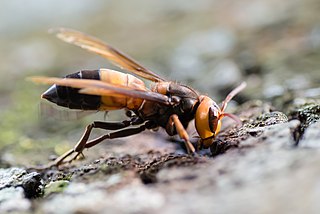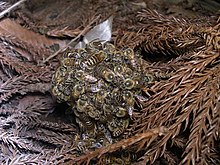
Bees are winged insects closely related to wasps and ants, known for their roles in pollination and, in the case of the best-known bee species, the western honey bee, for producing honey. Bees are a monophyletic lineage within the superfamily Apoidea. They are currently considered a clade, called Anthophila. There are over 20,000 known species of bees in seven recognized biological families. Some species – including honey bees, bumblebees, and stingless bees – live socially in colonies while most species (>90%) – including mason bees, carpenter bees, leafcutter bees, and sweat bees – are solitary.

A honey bee is a eusocial flying insect within the genus Apis of the bee clade, all native to mainland Afro-Eurasia. After bees spread naturally throughout Africa and Eurasia, humans became responsible for the current cosmopolitan distribution of honey bees, introducing multiple subspecies into South America, North America, and Australia.

Hornets are the largest of the eusocial wasps, and are similar in appearance to their close relatives yellowjackets. Some species can reach up to 5.5 cm (2.2 in) in length. They are distinguished from other vespine wasps by the relatively large top margin of the head. Worldwide, 22 species of Vespa are recognized. Most species only occur in the tropics of Asia, though the European hornet is widely distributed throughout Europe, Russia, North America, and north-eastern Asia. Wasps native to North America in the genus Dolichovespula are commonly referred to as hornets, but all of them are actually yellowjackets.

The Asian giant hornet or northern giant hornet, including the color form referred to as the Japanese giant hornet, is the world's largest hornet. It is native to temperate and tropical East Asia, South Asia, Mainland Southeast Asia, and parts of the Russian Far East. It was also found in the Pacific Northwest of North America in late 2019 with a few more additional sightings in 2020, and nests found in 2021, prompting concern that it could become an invasive species. However, by the end of the season in November 2022, there were no confirmed sightings in North America at all, suggesting they may have been eradicated in that region.

Waggle dance is a term used in beekeeping and ethology for a particular figure-eight dance of the honey bee. By performing this dance, successful foragers can share information about the direction and distance to patches of flowers yielding nectar and pollen, to water sources, or to new nest-site locations with other members of the colony.

The dwarf honey bee, Apis florea, is one of two species of small, wild honey bees of southern and southeastern Asia. It has a much wider distribution than its sister species, Apis andreniformis. First identified in the late 18th century, Apis florea is unique for its morphology, foraging behavior and defensive mechanisms like making a piping noise. Apis florea have open nests and small colonies, which makes them more susceptible to predation than cavity nesters with large numbers of defensive workers. These honey bees are important pollinators and therefore commodified in countries like Cambodia.

Apis andreniformis, or the black dwarf honey bee, is a relatively rare species of honey bee whose native habitat is the tropical and subtropical regions of Southeast Asia.

Apis laboriosa or Himalayan giant honey bee, is the world's largest honey bee; single adults can measure up to 3.0 cm (1.2 in) in length. Before 1980, Apis laboriosa was considered to be a subspecies of the widespread Apis dorsata, the giant honey bee, but in 1980 and for almost 20 years thereafter it was elevated to the rank of a separate species. It was classified once again as a subspecies of Apis dorsata by Michael S. Engel in 1999, but was confirmed as a full species in 2020 on the basis of co-occurrence with Apis dorsata at many sites with no sign of interbreeding. It is highly adapted to its highland habitat in behavior.

Apis koschevnikovi, Koschevnikov's honey bee, is a species of honey bee which inhabits Malaysian and Indonesian Borneo, where it lives sympatrically with other honey bee species such as Apis cerana.

Apis nigrocincta is a species of honey bee that inhabits the Philippine island of Mindanao as well as the Indonesian islands of Sangihe and Sulawesi. The species is known to have queens with the highest mating frequencies of any species of the tribe Apini.

Apis dorsata, the rock bee or giant honey bee, is a honey bee of South and Southeast Asia. They are typically around 17–20 mm (0.7–0.8 in) long and nests are mainly built in exposed places far off the ground, like on tree limbs, under cliff overhangs, and under buildings. These social bees are known for their aggressive defense strategies and vicious behavior when disturbed. Though not domesticated, indigenous peoples have traditionally used this species as a source of honey and beeswax, a practice known as honey hunting.

Bees can suffer serious effects from toxic chemicals in their environments. These include various synthetic chemicals, particularly insecticides, as well as a variety of naturally occurring chemicals from plants, such as ethanol resulting from the fermentation of organic materials. Bee intoxication can result from exposure to ethanol from fermented nectar, ripe fruits, and manmade and natural chemicals in the environment.

The western honey bee or European honey bee is the most common of the 7–12 species of honey bees worldwide. The genus name Apis is Latin for "bee", and mellifera is the Latin for "honey-bearing" or "honey carrying", referring to the species' production of honey.

Apis cerana indica, the Indian honey bee, is a subspecies of Asiatic honey bee. It is one of the predominant bees found and domesticated in India, Pakistan, Nepal, Myanmar, Bangladesh, Sri Lanka, Thailand and mainland Asia. Relatively non-aggressive and rarely exhibiting swarming behavior, it is ideal for beekeeping.

Cymbidium floribundum, the yellow margin orchid, golden leaf-edge orchid or golden-edged orchid, is a species of orchid.

The Asian hornet, also known as the yellow-legged hornet or Asian predatory wasp, is a species of hornet indigenous to Southeast Asia. It is of concern as an invasive species in some other countries, including most of Europe.

Apis cerana, the eastern honey bee, Asiatic honey bee or Asian honey bee, is a species of honey bee native to South, Southeast and East Asia. This species is the sister species of Apis koschevnikovi and both are in the same subgenus as the western (European) honey bee, Apis mellifera. A. cerana is known to live sympatrically along with Apis koschevnikovi within the same geographic location. Apis cerana colonies are known for building nests consisting of multiple combs in cavities containing a small entrance, presumably for defense against invasion by individuals of another nest. The diet of this honey bee species consists mostly of pollen and nectar, or honey. Moreover, Apis cerana is known for its highly social behavior, reflective of its classification as a type of honey bee.

Dendrobium christyanum is a species of orchid (Orchidaceae) endemic to the Chinese island of Hainan.

3-Hydroxyoctanoic acid is a beta-hydroxy acid that is naturally produced in humans, other animals, and plants.

Vespa soror, also known as the southern giant hornet, is a species of hornet present in India, Northern Thailand, Laos, Northern Vietnam, and parts of South China, including Hong Kong, Guangdong, Fujian, and Hainan Island.




















